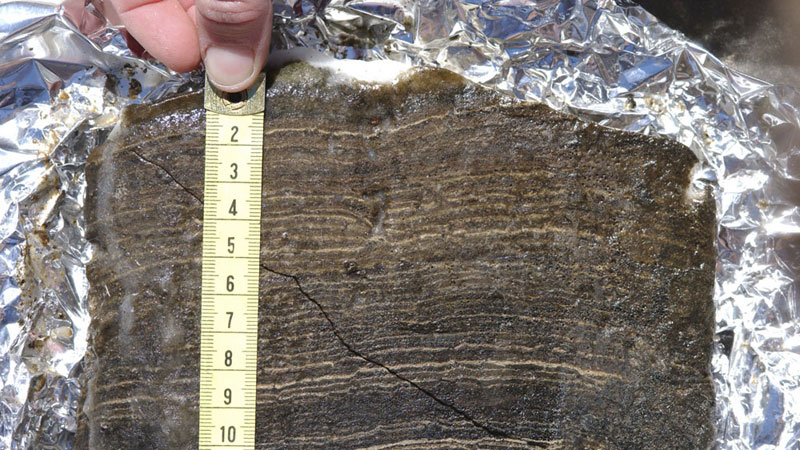
A sample of sediment layers from Crawford Lake
The recent cold spell didn’t deter Brock professor Francine McCarthy from getting outside. In fact, the colder it was, the better.
The Earth Sciences professor took to the outdoors to extract core samples from Crawford Lake near Milton. This field work from Crawford Lake will provide McCarthy and her fellow researchers with an opportunity to study changes in climate and in the lake itself over the past several thousand years, and to contribute to the geoarcheology of the region.
The cold weather didn’t bother McCarthy.
“It was only -5 C, so it wasn’t that cold. The main thing is we can walk on the lake when it’s frozen. It’s a lot easier to work from the ice surface than from a boat,” said McCarthy.

Francine McCarthy
“Crawford Lake is very deep even though it is relatively small, so the bottom waters are anoxic (an absence of oxygen).
“This results in excellent preservation of organic material that falls onto the lake bed, and absolutely no disturbance of the sediments, which allows for annual sediment layers (varves) to be preserved.”
The “frigid fingernail” sampler that McCarthy uses allows these varves to be collected intact (see above photo of the uppermost part of the core). This allows McCarthy to date changes in the lake’s history very precisely.
“One of my graduate students, Andrea Krueger, is studying the cysts produced by a relatively common form of microscopic floating algae, called a dinoflagellate,” said McCarthy.
Because there is a very well-documented period of Iroquoian settlement in the middle of the last millennium followed several centuries later by Euro-Canadian settlers, McCarthy’s team hopes to see how the dinoflagellates responded to the different types of land use during these two periods and to the absence of human impact during the intervening centuries.
This could provide a useful tool to study eutrophication, the increase of productivity in an ecosystem, which is a form of pollution.
McCarthy and her collaborators from the University of Toronto and the University of Innsbruck (Austria) caught the attention of The Weather Network. They were featured as they collected sediment cores. The TWN crew will again visit McCarthy in her Brock lab today.
She’s looking forward to the TWN’s follow-up visit “to explain a bit more to The Weather Network viewers about our work.”










I could add that a study of the varved deposits at Crawford lake about 40 years ago led to the discovery of an Iroquois village. The discovery of corn pollen in the deposits dating to about 1600’s was the key. A native people’s specialist from UWO was asked to point out the likeliest site of the presumed village. Indeed he succeeded on the first guess. After many years of archeological research at the site, the village was reconstructed ,together with its long houses on exactly the same foundations that had existed 400 years ago.Today the whole area is a park and cetrtainly is worth the drive to enjoy the lake ,with cliff-like shores, and the village.At the end of February they also feature a sugar bush.